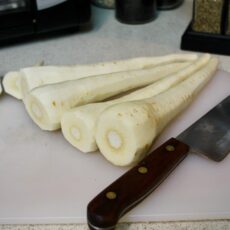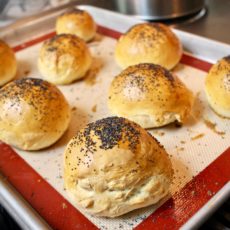Simply Delicious dedicates its last few chapters to “Cooking School“, comprised of informational cards on various techniques, ingredients, & basic recipes that any serious cook should learn to master. 18-9: Pasta I is the first in a two-part series about pasta, the second being 18-10: Pasta II. This particular card covers a few different shapes of pasta, including spaghetti, fettuccini, & lasagna. 🍽

18-9: Pasta I only begins to scratch the surface of different types of pasta–there are so many more out there. The important takeaways from this particular set of tips are the different kinds of sauce that go with the various shapes, as well as how to identify some common variances in the shapes. 18-10: Pasta II goes more into the cooking and serving of pasta, as well as listing a few more shape/sauce combinations if you’re looking for a bit more from Simply Delicious on the topic. 📚

There’s not much more I can add to what they’ve written besides some more links and a few pasta-related stories (the first time I made mac-and-cheese from a box I didn’t drain it after boiling the noodles, just added the cheese, milk, & butter right into the starchy water), so I’ll use the rest of this space to highlight some different recipes I’ve already covered that use these types of pastas. If I don’t have one for a particular type yet, I’ll update it when I do. 💻

Spaghetti, vermicelli, & angel’s hair pasta: Defined as pasta rods, these long, thin strand-like types of pasta (and others similar) are great for light tomato, cream, or broth-based sauces. Keep in mind that these types of pasta are sometimes difficult to eat, especially without getting messy, so consider a smaller size/shape of pasta for party-type events (unless you’re purposely having a big spaghetti dinner). 🍝
- 12-3: Pasta Bolognese (pictured above)
- 12-6: Seasoned Pasta Toss
- 12-40: Spinach Pasta with Mushrooms
- 12-41: Spaghetti with Green Sauce

Fettuccini, tagliatelle, & mafalde: Defined as pasta ribbons, these long, flat, ribbons of pasta are ideal for heavier sauces–the sauce needs something it can actually cling onto, but you also don’t want your pasta drowning underneath a heavy sauce. These thicker ribbons can carry a heavy sauce but still remain a big component of the dish–something with which thinner rod-like pastas struggle. 🎀
- 12-7: Fettuccini with Creamy Chicken
- 12-10: Cheesy Tagliatelle (pictured above)
- 12-17: Curly Pasta with Creamy Chicken
- 12-20: Fettuccini with Ham
- 12-26: Pasta with Creamy Shrimp

Lasagna & cannelloni: Lasagna falls into the ribbon-type pasta category above (like a fettuccini or tagliatelle), but cannelloni and manicotti are definitely in the pasta tubes category along with smaller iterations such as penne (on which 18-10: Pasta II goes into more detail). Large tube pastas like these are great for stuffing and/or layering, which is probably why Simply Delicious grouped them with lasagna–they all make make great casserole-type baked pasta dishes. 🍲
I haven’t made any manicotti dishes yet, but they’re in the book waiting for me–you’ll have to live with just lasagna and cannelloni dishes for now.
- 12-1: Lasagna (pictured above)
- 12-24 : Cannelloni with Chicken
- 12-27: Chicken Broccoli Lasagna
- 12-33: Individual Beef Lasagna
- 13-15: Vegetarian Lasagna
I hope I didn’t bore you too much with my deep dive on pasta–I’m really into all the different types of shapes and for what kinds of dishes you use them. If this wasn’t enough pasta for you, check out the next in the pasta series, 18-10: Pasta II–there’s so much more I have to tell you about it! 😅



